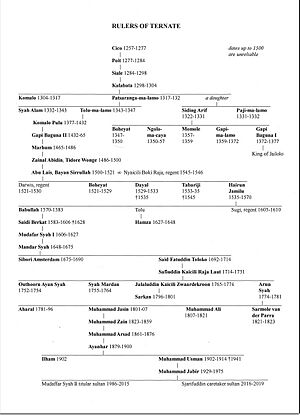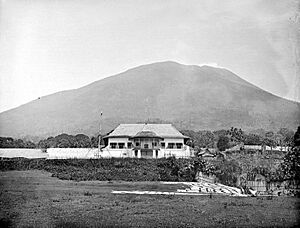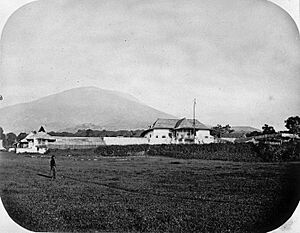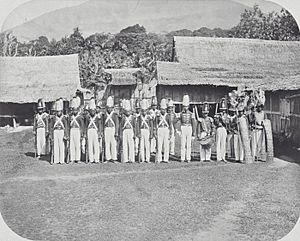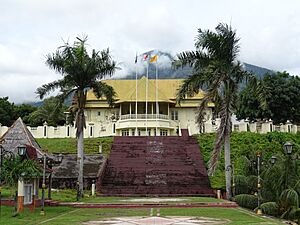Sultanate of Ternate facts for kids
Quick facts for kids
Sultanate of Ternate
کسلطانن ترناتي
Kesultanan Ternate |
|||||||
|---|---|---|---|---|---|---|---|
| 1257/1486–1914 | |||||||
|
Flag
|
|||||||

Greatest extent of the Sultanate of Ternate c. 1585
|
|||||||
| Capital | Ternate
Gammalammo (royal capital 1575-1606) |
||||||
| Common languages | Ternate, Malay, Portuguese (from 16th to 17th century), and Portuguese based creole. | ||||||
| Religion |
|
||||||
| Government | Sultanate | ||||||
| Sultan Alam ma-kolano |
|||||||
|
• 1257 – 1277
|
Baab Mashur Malamo | ||||||
|
• 1486 – 1500
|
Zainal Abidin of Ternate (first sultan) | ||||||
|
• 1902 – 1915
|
Muhammad Usman Shah (last sultan to rule Ternate) | ||||||
| History | |||||||
|
• Founded
|
1257 | ||||||
|
• Conversion to Islam
|
1486 | ||||||
|
• Vassalisation by Dutch
|
1683 | ||||||
|
• Final ruler dethroned by Dutch
|
1914 | ||||||
|
• Honorary sultan crowned
|
1929 | ||||||
|
|||||||
| Today part of | Indonesia | ||||||
The Sultanate of Ternate was an important kingdom in Indonesia. It was one of the first Muslim kingdoms in the region. It existed for many centuries, from 1257 until 1914. Today, Ternate is part of Indonesia.
This powerful kingdom was known for its clove production. Cloves are a valuable spice. Ternate became very rich and strong because of this trade. At its peak, it controlled much of eastern Indonesia and parts of the southern Philippines.
The royal family of Ternate still exists today. However, they no longer have political power. They keep the traditions and culture of the sultanate alive.
Contents
History of Ternate
Early Days of the Kingdom
The kingdom was first called the Kingdom of Gapi. Later, it changed its name to Ternate, after its capital city. Ternate originally had four villages. Each village was led by a chief called a Momole.
People in these villages traded spices with merchants from Arab countries, Malaysia, and China. This spice trade was very profitable. But it also attracted pirates. To protect themselves, the villages decided to form a stronger kingdom.
One story says that Momole Guna suggested creating a kingdom. Momole Cico was chosen as the first king. He was given the title Baab Mashur Malamo. Another story tells of an Arab ancestor of the Malukan kings. He supposedly married a heavenly nymph. Their four sons became the ancestors of the four main kingdoms in Maluku: Bacan, Jailolo, Tidore, and Ternate.
Ternate and its neighbor, Tidore, were the main producers of cloves in the world. This made their rulers very wealthy. However, they often fought each other. These fights sometimes wasted their riches.
Islam Arrives in Ternate
Ternate was one of the first places in the region to adopt Islam. This happened because of its strong trade connections. Islam came from Java in the late 1400s.
At first, only the royal family of Ternate became Muslim. The faith slowly spread to the rest of the people. Sultan Marhum (1465–1486) was the first king to embrace Islam.
His son, Zainal Abidin (1486–1500), made Islam the official religion. He changed the kingdom into an Islamic Sultanate. The title of Kolano (king) was then replaced with Sultan.
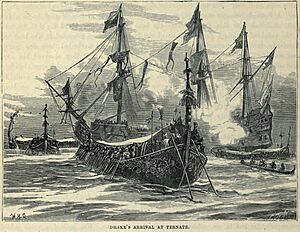
Ternate's power was strongest in the late 1500s. This was during the rule of Sultan Baabullah (1570–1583). His influence reached across eastern Sulawesi, the Ambon and Seram areas, Timor island, and parts of the southern Mindanao and Papuan Islands.
Ternate often competed fiercely with the nearby Sultanate of Tidore. Their rivalry was a major part of the early history of the Maluku Islands. Ternate also played a role in the politics of Philippine kingdoms. It once had a conflict with the Boholano people.
Europeans Arrive
The first Europeans to reach Ternate were the Portuguese. Their ship was wrecked near Seram in 1512. Sultan Bayan Sirrullah of Ternate (1500–1522) helped them. He hoped to form an alliance with this powerful foreign nation.
The Portuguese were allowed to build a fort on the island. This fort is known today as Kastella. Construction began in 1522. However, relations between the Ternateans and Portuguese quickly became difficult. Ternate started to build closer ties with the Ottomans.
The Portuguese often behaved poorly. They also tried to convert the local Muslims to Christianity. This made relations even worse. In 1535, the Portuguese removed Sultan Tabariji from power. They sent him to Goa, India. He became a Christian there. He died on his way back to Ternate in 1545.
After the Portuguese killed Sultan Hairun, the people of Ternate fought back. They expelled the Portuguese in 1575 after a five-year siege. Ambon became the new center for Portuguese activities. Ternate then became a strong Islamic state under Sultan Baab Ullah (1570–1583).
Later, Spanish forces captured the former Portuguese fort in 1606. They were helped by the Boholano people, who had previously fought Ternate. The Spanish sent the Ternate Sultan and his group to Manila in the Spanish Philippines.
In 1607, the Dutch arrived in Ternate. With the help of the Ternateans, they built a fort. The island was then divided. The Spanish were allied with Tidore, and the Dutch with Ternate. For the Ternatean rulers, the Dutch were helpful allies against Tidore and the Spanish.
Under Sultan Hamzah (1627–1648), Ternate expanded its territory. The Dutch East India Company (VOC) gained some control over certain regions. This was in exchange for helping Ternate control rebellions. The Spanish left Maluku in 1663. Many people of mixed Moluccan-Portuguese and Filipino-Mexican descent moved to Ternate, Cavite in the Philippines. They still speak a unique language called Ternateño Chavacano.
Sultan Sibori Amsterdam (1675–1691) wanted to restore Ternate's former glory. He declared war on the Dutch. But Ternate's power had weakened. He lost and was forced to give more land to the Dutch in 1683. Ternate lost its equal standing and became a vassal state. However, the Dutch never fully controlled Ternate until 1914.
Ternate in Later Centuries
In the 1700s, Ternate was a center for Dutch trade control in the northern Moluccas. By the 1800s, the spice trade had declined. The region became less important to the Dutch. However, they kept a presence to prevent other European powers from taking over.
After the Dutch government took over the VOC in 1800, Ternate became part of the Dutch colonial administration. British forces briefly occupied Ternate in 1810. It was returned to Dutch control in 1817.
Sultan Haji Muhammad Usman (1902–1914) tried to resist the Dutch. He secretly supported local revolts. He failed and was removed from power. His wealth was taken, and he was sent away to Bandung. This marked the end of the traditional Ternatean kingdom.
The throne was empty from 1914 to 1929. Then, Crown Prince Iskandar Muhammad Jabir became the next Sultan. He ruled when the Japanese arrived in 1942. He was later taken to Australia by the Allies.
After 1950, the Sultan lived in Jakarta. He tried to bring back old royal traditions in the 1960s. But the sultanate ended after his death in 1975. His son, Mudaffar, became a ceremonial head in 1986. He restored many traditions. Sultan Mudaffar Sjah II died in 2015.
The Sultan's Palace
The current Sultan's palace, called the kadaton, was built starting in 1781. It has been restored and now looks partly like a colonial-style building. Today, it is both a museum and the Sultan's home.
The museum shows the family history of the Ternate royal family, going back to 1257. It also has old Portuguese and Dutch helmets, swords, and armor. You can also see items that belonged to past sultans.
Ternate's Lasting Impact
Even though the Ternate empire declined in the 1600s, its influence lasted for centuries. Ternate had a huge impact on the culture of eastern Indonesia. This includes its religion, customs, and language.
As the first kingdom to become Muslim, Ternate played a big role in spreading Islam in eastern Indonesia and the southern Philippines. The way Ternate organized its empire and applied Islamic law became a model for other kingdoms in Maluku.
The victory of the Ternate people under Sultan Baabullah against Portugal in 1575 was very important. It was the first time a local kingdom defeated a Western power in the archipelago. Some historians believe this victory delayed European control of the region for 100 years. It also helped strengthen Islam in the area.
Ternate's importance also helped raise the status of the Ternate Language. It became a common language for trade and communication in many areas under its influence. The Ternate language greatly influenced the Malay language spoken in eastern Indonesia. For example, 46% of the Malay words used in Manado come from Ternate.
The North Moluccan Malay language, which is based on Ternate Malay, is now widely spoken in eastern Indonesia. This includes North Sulawesi, parts of Central and South Sulawesi, Maluku, and Papua.
Two letters written by Sultan Abu Hayat II to the King of Portugal are very old. They were written in the early 1520s. These letters are considered some of the oldest Malay writings in the world. They are kept in the Museum of Lisbon in Portugal.
Images for kids
-
Ternatean galleys welcomed the arrival of Francis Drake.
See also
- Spice trade
- Portuguese-Ternate wars
- List of Sunni Muslim dynasties
- List of rulers of Maluku




